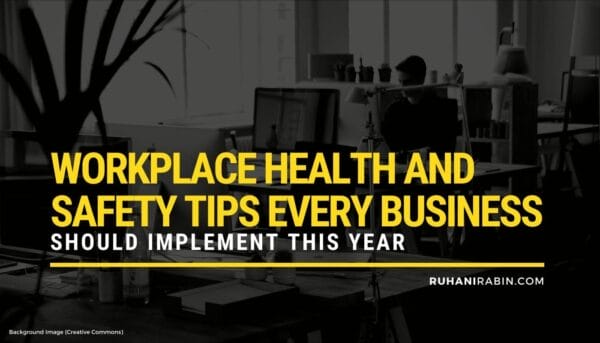The pandemic may slowly be dying down in certain parts of the globe, but it’s still raging in others. And although Covid-19 has been our main health preoccupation for over a year, as we slowly go back to work from our regular offices, there are other health and safety measures we should also be implementing.
Let’s take a look at this list of workplace health and safety tips you should make your top priority this year.
Accept that covid-19 is here to stay
Even as vaccination plans have been rolled out in most countries, the acute risk of contracting coronavirus is still present. This means that companies will still need to maintain social distancing measures, instruct employees to wear masks, and have their offices cleaned and disinfected regularly.
You should also make it a point to discuss personal hygiene with your staff. Ensure everyone is doing everything in their power to minimize the potential risk of contracting and spreading diseases, including but not limited to Covid-19.
Remind everyone how to provide first aid
Even if your staff has undergone extensive first aid training, chances are this was a while back. They probably need a refresher. After all, it’s everyone’s job to ensure workplace health and wellness. Do your part by offering new courses and fresh training.
If an accident occurs, you want the people on hand to provide immediate help while you wait for an ambulance. More importantly, knowing how to handle a crisis such as a heart attack or a stroke can literally save someone’s life. So, make sure everyone knows what the appropriate steps in these situations are.
Focus on mental health
The importance of mental health has finally started penetrating into the world of work health and safety. Pre-covid, we were focused on interpersonal office dynamics, burnout, the consequences of stress, and similar topics. But now, the effects of the pandemic will force us to widen the mental health counseling and understanding we provide. This might mean you need to brush up on your Health and Safety Representative training after the break from the office to ensure the workplace can operate safely.
When you welcome your employees back to the office, make sure you clearly let them know it’s okay to feel unsafe and unmotivated. The new break in their routine will certainly cause some upsets.

Don’t expect things to go back to what they were pre-2020. Mental health issues have been on the rise ever since the pandemic first started to develop. Now, a lot of your employees may be facing challenges they have never experienced before.
Demonstrate your care and understanding by offering more flexibility, the chance to talk to someone, and a zero-tolerance policy towards bullying or name-calling. Let your staff feel like they can come to you when their mental health is suffering. The helping hand you lend will ultimately make them much more productive.
After all, how you handle your workplace health and safety issues speaks volumes about who you are as an employer.
Repetitive Stress Injuries from Work from Home
Due to the COVID-19 pandemic, many people been working from home. Most of the time, the way they sit and work arrangement at home are not well placed for long hours of Work. Work from home-related injuries caused by poor posture and repetitive motions are an emerging occupational health concern. Many Americans spend a lot of time on computers, using their mouse and keyboard for hours at a time, overusing specific muscles and joints. And now these happen at their own home because they do not have a proper workplace setup at home too.

Poor posture when using electronic devices (both on and off the clock), modern workers are likely to experience medical costs, long-term pain, and lost productivity.
Many employers have found that investing the lessons for the employees in ergonomics and safety initiatives (such as fall prevention) actually generates a positive return on investment when losses in productivity and medical costs are considered.
Identify your hazards
Now that everyone is back in the office, it’s time to identify the potential hazards of having all these people in the same space and using all of that equipment.
Your best bet is to call in the experts. Have a health and safety company go over your premises and identify any issues or dangers.
You can do it yourself, too, as some hazards will be particularly easy to spot. You may have some faulty cables, a dishwasher that’s on its last legs, or slippery stairs.
Consider everything from fire and chemicals to slip and fall hazards. Make sure your fire extinguishers, sprinklers, and any other safety equipment is working as it should.
Eliminate your hazards
Once you have a clear list of hazards that need taking care of, start working on eliminating them one by one. Start with the most dangerous ones and work your way down the list.
If there are hazards that you can’t eliminate for whatever reason (like slippery stairs), issue appropriate warnings. Provide your staff with all the information they may need to prevent an accident or to react if something unwanted does occur.
Keep a list of these hazards at all times. Review it regularly and keep adding to it every few months. It’s important to understand what may happen at the office and what the best ways to tackle an arising situation are.
Take Breaks On A Regular Basis
A worker who is burned out is at an increased risk of getting sick or injured at work because they aren’t alert to their surroundings. Maintain a healthy work-life balance by taking regular breaks. You may want to schedule your most difficult jobs when you first arrive on the job. The more alert you are, the better.
Talk to your staff about Workplace Health and Safety
Finally, you want to make sure to also chat with your staff and get their views on the health and safety risks and solutions you have at the premises. They may be able to identify a potential risk you haven’t even been aware of. Or, they may have personal experience with dealing with similar situations.
This is also an excellent way to have a more open chat about the general state of the office. Perhaps some of your employees dislike the desks and chairs and have started developing back pain or headaches? You are not likely to identify this issue without hearing from those affected, so keeping the communication lines open and honest is always incredibly important.
Final thoughts on Workplace Health and Wellness
Workplace Health and safety is a topic we would rather not think about. It’s tedious and boring, and there are so many other, just as important tasks we would prefer to be tackling.
However, as the saying goes, it’s better to be safe than sorry. A preventable accident in the workplace can cost you not only a lot of money but also your reputation. And the bad press can damage any business beyond repair.
Take the time to handle the mundane aspects of health and safety in the workplace, and if anything you’ve been preparing for ever happens, you’ll be glad you did. Even if it doesn’t, just be happy you’ve prepared in advance.




